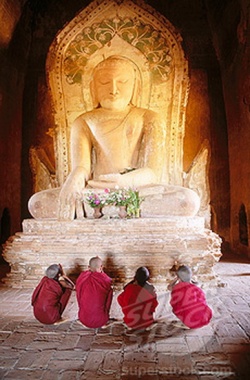Difference between revisions of "Wang ocheonchukguk jeon"
m (Text replacement - "Central Asia" to "{{Wiki|Central Asia}}") |
|||
| Line 1: | Line 1: | ||
| − | + | [[File:SuperStouy2451.jpg|thumb|250px|]] | |
| − | Wang ocheonchukguk jeon (Korean pronunciation: [waːŋotɕʰʌntɕʰukk͈uktɕ͈ʌn]; pinyin: wǎng wǔ tiānzhú guó chuán; "An account of travel to the five Indian kingdoms") is a travelogue by Buddhist monk Hyecho, who traveled from Korea to India, in the years 723 - 727/728 CE. | + | [[Wang ocheonchukguk jeon]] ([[Korean]] pronunciation: [waːŋotɕʰʌntɕʰukk͈uktɕ͈ʌn]; pinyin: [[wǎng wǔ tiānzhú guó chuán]]; "[[An account of travel to the five Indian kingdoms]]") is a travelogue by [[Buddhist monk]] [[Hyecho]], who traveled from [[Korea]] to [[India]], in the years 723 - 727/728 CE. |
| − | Written in Classical Chinese, the lingua franca of East Asia at the time, the work was long thought to be lost. However, a manuscript turned up among the Dunhuang manuscripts during the early 20th century. It was bought by French explorer and archaeologist Paul Pelliot in 1908, and is now owned by the National Library of France (Pelliot chinois 3532). | + | Written in Classical {{Wiki|Chinese}}, the lingua franca of {{Wiki|East Asia}} at the [[time]], the work was long [[thought]] to be lost. However, a {{Wiki|manuscript}} turned up among the [[Dunhuang]] manuscripts during the early 20th century. It was bought by {{Wiki|French}} explorer and archaeologist {{Wiki|Paul Pelliot}} in 1908, and is now owned by the National Library of {{Wiki|France}} (Pelliot chinois 3532). |
| − | The manuscript scroll contains 5,893 classical Chinese characters in 227 lines. It originally consisted of three volumes, however volume one and later section of volume three are lost. It is 28.5 centimeters in width and 358.6 centimeters in length, is the first known overseas travelogue written by a Korean and contains information about the political, cultural and economic customs of India and central Asia at that time. The five Indian kingdoms in the work's title refer to West, East, North, South and Central India, but it also contains information about the Byzantine Empire (Greater Fu-lin), the Arabs, Persia and several {{Wiki|Central Asia}}n states. | + | The {{Wiki|manuscript}} scroll contains 5,893 classical {{Wiki|Chinese}} characters in 227 lines. It originally consisted of three volumes, however volume one and later section of volume three are lost. It is 28.5 centimeters in width and 358.6 centimeters in length, is the first known overseas travelogue written by a [[Korean]] and contains [[information]] about the {{Wiki|political}}, {{Wiki|cultural}} and economic customs of [[India]] and central {{Wiki|Asia}} at that [[time]]. The five [[Indian]] {{Wiki|kingdoms}} in the work's title refer to [[West]], [[East]], [[North]], [[South]] and Central [[India]], but it also contains [[information]] about the {{Wiki|Byzantine}} [[Empire]] (Greater Fu-lin), the Arabs, {{Wiki|Persia}} and several {{Wiki|Central Asia}}n states. |
| − | It was loaned to the National Museum of Korea and went on display there from Dec. 18, 2010 to April 3, 2011, 1283 years after the document was first written. | + | It was loaned to the National Museum of [[Korea]] and went on display there from Dec. 18, 2010 to April 3, 2011, 1283 years after the document was first written. |
{{W}} | {{W}} | ||
[[Category:Korea]] | [[Category:Korea]] | ||
[[Category:Mahayana texts]] | [[Category:Mahayana texts]] | ||
Latest revision as of 14:34, 19 March 2014
Wang ocheonchukguk jeon (Korean pronunciation: [waːŋotɕʰʌntɕʰukk͈uktɕ͈ʌn]; pinyin: wǎng wǔ tiānzhú guó chuán; "An account of travel to the five Indian kingdoms") is a travelogue by Buddhist monk Hyecho, who traveled from Korea to India, in the years 723 - 727/728 CE.
Written in Classical Chinese, the lingua franca of East Asia at the time, the work was long thought to be lost. However, a manuscript turned up among the Dunhuang manuscripts during the early 20th century. It was bought by French explorer and archaeologist Paul Pelliot in 1908, and is now owned by the National Library of France (Pelliot chinois 3532).
The manuscript scroll contains 5,893 classical Chinese characters in 227 lines. It originally consisted of three volumes, however volume one and later section of volume three are lost. It is 28.5 centimeters in width and 358.6 centimeters in length, is the first known overseas travelogue written by a Korean and contains information about the political, cultural and economic customs of India and central Asia at that time. The five Indian kingdoms in the work's title refer to West, East, North, South and Central India, but it also contains information about the Byzantine Empire (Greater Fu-lin), the Arabs, Persia and several Central Asian states.
It was loaned to the National Museum of Korea and went on display there from Dec. 18, 2010 to April 3, 2011, 1283 years after the document was first written.
